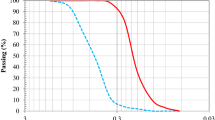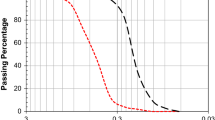Abstract
The brittle nature of reactive powder concrete (RPC) and existence of inertial stress (at high strain rates) made it suffer tensile failure and seriously affected the safety of concrete structure. Graphene with low density and small size easily dispersed in concrete matrix, while its high stiffness and diameter-to-thickness ratio could effectively offset the inertia stress, contributing to improve the energy absorption of the concrete. In this paper, the RPC was nano-modified by combining the characteristics of graphene and concrete. The mechanical behaviors of RPC under different strain rates were systematically studied, and the effects of graphene on mechanical performance of RPC were analyzed. Finally, the reinforcing mechanisms of graphene on RPC were understood, and the dynamic compression constitutive of RPC was established, which provided a theoretical basis for understanding the dynamic mechanical properties and behaviors of this concrete material for the first time. Experimental results showed that under quasi-static loads, the incorporation of graphene significantly enhanced the compressive toughness of RPC. Under the high rate dynamic loads (strain rate of 200–800/s), the dynamic compressive strength, peak strain and ultimate strain of graphene-reinforced RPC were increased by 59.1 MPa/63.9%, 4300 με/66.0% and 12150 με/32.7%, respectively. Additionally, the impact toughness of RPC was increased by 117%. The reinforcing mechanisms of graphene on RPC were mainly attributed to their nucleation and bridging effect. Furthermore, the interlaminar slip and structural fracture of graphene further absorbed strain energy released by cracking and therefore improved the mechanical properties of the RPC.
















Similar content being viewed by others
References
Doroud K, Moshaii A, Pezeshkian Y, Rahighi J, Afarideh H (2009) Simulation of temperature dependence of RPC operation. Nucl Instrum Methods Phys Res Sect A 602(3):723–726
Lee M, Wang GYC, Chiu CA (2007) Preliminary study of reactive powder concrete as a new repair material. Constr Build Mater 21(1):182–189
Richard P, Cheyrezy MH (1995) Reactive powder concrete. Cem Concr Res 25(7):1501–1511
Cheyrezy M, Maret V, Frouin L (1995) Microstructural analysis of RPC (reactive powder concrete). Cem Concr Res 25(7):1491–1500
Abid M, Hou X, Zheng W, Hussain RR (2017) High temperature and residual properties of reactive powder concrete–A review. Constr Build Mater 147:339–351
Wang Y, Wang Z, Liang X, An M (2008) Experimental and numerical studies on dynamic compressive behavior of reactive powder concretes. Acta Mech Solida Sin 21(5):420–430
Glinicki MA (1993) Tensile stress–strain behavior of cementitious composites at high loading rates. J Mater Sci 28(8):2148–2156. https://doi.org/10.1007/BF00367576
Ulus H, Üstün T, Şahin ÖS, Karabulut SE, Eskizeybek V, Avci A (2016) Low-velocity impact behavior of carbon fiber/epoxy multiscale hybrid nanocomposites reinforced with multiwalled carbon nanotubes and boron nitride nanoplates. J Compos Mater 50(6):761–770
Li VC, Leung CKY (1992) Theory of steady state and multiple cracking of random discontinuous fiber reinforced brittle matrix composites. J Eng Mech 118(11):2246–2264
Okeil AM, EI-Tawil S, Shahawy M (2001) Short-term tensile strength of carbon fiber-reinforced polymer laminates for flexural strengthening of concrete girders. ACI Str J 98(4):470–478
Lim TY, Paramasivam P, Lee SL (1987) Analytical model for tensile behavior of steel-fiber concrete. ACI Mater J 84(4):286–298
Xu Z, Hao H, Li HN (2012) Experimental study of dynamic compressive properties of fiber reinforced concrete material with different fibers. Mater Des 33:42–55
Branston J, Das S, Kenno SY, Taylor C (2016) Mechanical behavior of basalt fiber reinforced concrete. Constr Build Mater 124:878–886
Sanchez F, Sobolev K (2010) Nanotechnology in concrete-A review. Constr Build Mater 24(11):2060–2071
García-Macías E, D’Alessandro A, Castro-Triguero R, Pérez-Mira D, Ubertini F (2017) Micromechanics modeling of the uniaxial strain-sensing property of carbon nanotube cement-matrix composites for SHM applications. Compos Struct 163:195–215
Liew KM, Kai MF, Zhang LW (2017) Mechanical and damping properties of CNT-reinforced cementitious composites. Compos Struct 160:81–88
Sasmal S, Ravivarman N, Sindu BS, Vignesh K (2017) Electrical conductivity and piezo-resistive characteristics of CNT and CNF incorporated cementitious nanocomposites under static and dynamic loading. Compos A 100:227–243
Miyandehi BM, Feizbakhsh A, Yazdi MA, Liu QF, Yang J, Alipour P (2016) Performance and properties of mortar mixed with nano-CuO and rice husk ash. Cem Concr Compos 74:225–235
Ma B, Li H, Mei J, Han L, Chen F (2015) Toughening effect and mechanism of nano-titanium dioxide on cement-based materials. J Funct Mater 46(12):12065–12069 (in Chinese)
Han BG, Sun SW, Ding SF, Zhang LQ, Yu X, Ou JP (2015) Review of nanocarbon-engineered multifunctional cementitious composites. Compos Part A 70(70):69–81
Li X, Korayem A, Li C, Liu Y, He H, Sanjayan J, Duan W (2016) Incorporation of graphene oxide and silica fume into cement paste: a study of dispersion and compressive strength. Constr Build Mater 123:327–335
Dimov D, Amit I, Gorrie O, Barnes MD, Townsend NJ, Neves AI, Craciun MF (2018) Ultrahigh performance nanoengineered graphene–concrete composites for multifunctional applications. Adv Funct Mater 28(23):1705183
Han B, Ding S, Wang J, Ou J (2019) Nano-engineered cementitious composites: principles and practices. Springer, Berlin
Bischoff PH, Perry SH (1995) Impact behavior of plain concrete loaded in uniaxial compression. J Eng Mech 121(6):685–693
Zhang H, Wang B, Xie A, Qi Y (2017) Experimental study on dynamic mechanical properties and constitutive model of basalt fiber reinforced concrete. Constr Build Mater 152:154–167
Dong S, Han B, Yu X, Ou J (2018) Dynamic impact behaviors and constitutive model of super-fine stainless wire reinforced reactive powder concrete. Constr Build Mater 184:602–616
Sun S, Ding S, Han B, Dong S, Yu X, Zhou D, Ou J (2017) Multi-layer graphene-engineered cementitious composites with multifunctionality/intelligence. Compos, Part B 129:221–232
Sun S, Han B, Jiang S, Yu X, Wang Y, Li H, Ou J (2017) Nano graphene platelets-enabled piezoresistive cementitious composites for structural health monitoring. Constr Build Mater 136:314–328
Fu Q, Xie Y, Long G, Niu D, Song H, Liu X (2017) Impact characterization and modelling of cement and asphalt mortar based on SHPB experiments. Int J Impact Eng 106:44–52
Miao Y, Li Y, Liu H, Deng Q, Shen L (2016) Determination of dynamic elastic modulus of polymeric materials using vertical split Hopkinson pressure bar. Int J Mech Sci 108–109:1881–1896
Wang Z, Liu Y, Shen R (2008) Stress-strain relationship of steel fiber-reinforced concrete under dynamic compression. Constr Build Mater 22(5):811–819
Zhou C, Li F, Hu J, Ren M, Wei J (2017) Enhanced mechanical properties of cement paste by hybrid graphene oxide/carbon nanotubes. Constr Build Mater 134:336–345
Wang J, Ding S, Han B, Ni YQ, Ou J (2018) Self-healing properties of reactive powder concrete with nanofillers. Smart Mater Struct 27(11):115033
Zohhadi N, Aich N, Matta F, Saleh NB, Ziehl P (2015) Graphene nano reinforcement for cement composites. In: Nanotechnol Eco-Effic. Constr (2nd Ed), pp 265–270
Ross C, Jerome D, Tedesco J, Hughes M (1996) Moisture and strain rate effects on concrete strength. ACI Mater J 93(3):293–298
Wu W, Zhang W, Ma G (2010) Mechanical properties of copper slag reinforced concrete under dynamic compression. Constr Build Mater 24(6):910–917
Zhou X, Hao H (2008) Modelling of compressive behavior of concrete-like materials at high strain rate. Int J Solids Struct 45(17):4648–4661
Li G, Gao B (2006) Effect of level SiO2 and level CaCO3 on concrete performance. J Chin Railw Soc 28(2):131–136 (in Chinese)
Zhou L, Kang Y, Guo J (2012) Theoretical model of double-walled carbon nanotube pullout from a composite matrix. Sci China Phys Mech Astron 55(6):1004–1009
Kaplan SA (2015) Factors affecting the relationship between rate of loading and measured compressive strength of concrete. Mag Concr Res 32(111):79–88
Xiao J, Li L, Shen L, Poon C (2015) Compressive behavior of recycled aggregate concrete under impact loading. Cem Concr Res 71:46–55
Lai J, Sun W (2009) Dynamic behavior and visco-elastic damage model of ultra-high performance cementitious composite. Cem Concr Res 39(11):1044–1051
Bischoff P, Perry S (1991) Compressive behavior of concrete at high strain rates. Mater Struct 24:45–50
Zhang M, Hu H, Li Q, Huang F (2007) Experimental study of the compressive strength of mortar using SHPB. In: Proceedings of 7th International conference on shock and impact loading structure, pp 707–714
Hao Y, Hao H, Li Z (2010) Numerical analysis of lateral inertial confinement effects on impact test of concrete compressive material properties. Int J Prot Struct 1(1):145–167
Fu JP, Yang JL, Yin LK, Liu W, Wang J, Chen Z (2016) Dynamic properties of zirconia ceramic bullets under high-speed impact. J Chin Ceram Soc 44(2):346–352 (in Chinese)
Zhang XX, Yu RC, Ruiz G (2010) Effect of loading rate on crack velocities in HSC. Int J Impact Eng 37:359–370
Lu G, Yu TY (2003) Energy absorption of structures and materials. Elsevier, Amsterdam
Cong XD, Kirkpatrick RJ (1996) 29Si MAS NMR study of the structure of calcium silicate hydrate. Adv Cem Based Mater 3(3):144–156
He YJ, Hu SG (2007) Application of 29Si nuclear magnetic resonance (NMR) in research of cement chemistry. J Mater Sci Eng 25(1):147–153
Wang J, Han B, Li Z, Yu X, Dong X (2019) Effect investigation of nanofillers on CSH gel structure with Si NMR. J Mater Civ Eng 31(1):04018352
Han B, Zhang L, Zeng S, Dong S, Yu Y, Yang R, Ou J (2017) Nano-core effect in nano-engineered cementitious composites. Compos Part A 95:100–109
Zheng Q, Geng Y, Wang S, Li Z, Kim JK (2010) Effects of functional groups on the mechanical and wrinkling properties of graphene sheets. Carbon 48:4315–4322
Wang L (2010) Foundation of stress waves. National Defense Industry Press, Beijing, pp 52–60 (in Chinese)
Loland LE (1980) Continuum damage model for load response estimation of concrete. Cem Concr Res 10:395–402
Hu S, Wang D (2002) Dynamic constitutive relation of concrete materials under impact loading. Explos Shock Waves 22(3):242–246 (in Chinese)
Funding
This study was funded by the National Science Foundation of China (51578110) and the Fundamental Research Funds for the Central Universities in China (DUT18GJ203).
Author information
Authors and Affiliations
Corresponding author
Ethics declarations
Conflict of interest
The authors declare that they have no conflict of interest.
Additional information
Publisher's Note
Springer Nature remains neutral with regard to jurisdictional claims in published maps and institutional affiliations.
Rights and permissions
About this article
Cite this article
Wang, J., Dong, S., Yu, X. et al. Mechanical properties of graphene-reinforced reactive powder concrete at different strain rates. J Mater Sci 55, 3369–3387 (2020). https://doi.org/10.1007/s10853-019-04246-5
Received:
Accepted:
Published:
Issue Date:
DOI: https://doi.org/10.1007/s10853-019-04246-5




